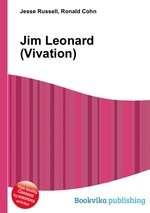Jim Leonard (Vivation)
Jesse Russell Ronald Cohn
бумажная книга
High Quality Content by WIKIPEDIA articles! Jim Leonard (June 2, 1955 – September 23, 2008) was an American teacher, author and an early pioneer of modern day Breathwork. He was the originator of Vivation and author of three books and numerous articles on human potential. Jim did not consider Vivation "Breathwork," although others have classified it as such. Jim considered Vivation a form of yoga. The focus of Vivation is on maintaining an attitude of curiosity and enjoyment of the sensations in the body, rather than a judgment of the sensations or suppression of the sensations in the body. Like with yoga, it is important in Vivation to not hold the breath as you monitor the sensations in the body. Like yoga, paying attention to the sensations in the body in an open, interested gentle way will lead your body to heal many physical and emotional wounds and connect you to peaceful, deep places inside yourself often referred to as spiritual. Yoga focuses on noticing the sensations that happen in the body when muscles are engaged and the body is put through its range of motion. In Vivation, the muscles of the body are totally relaxed. The focus in yoga is keeping the breath comfortable and relaxed and not forced or suppressed. It is the rate of the breath is flexible in Vivation, not the body. In both Vivation and yoga, it is important to not hold the breath. In yoga holding the breath makes the physical activity hard so that you can`t focus on sensations in the body. In Vivation holding the breath makes it impossible to notice the sensations which is the goal for tapping into the healing properties of both yoga and Vivation. This is why deep slow breathing to relax in some circumstances has a paradoxical affect on some emotionally stressed people. It causes unpleasant emotional sensation (emotions) to become stronger and thus they become overwhelmed. The only requirement for the breath in Vivation is that you don`t hold your breath and you focus on breathing in. This means the in breath and the out breath are continuous without pauses. Faster and deeper breathing increases the strength of sensations, and slower and deeper breathing increases the strength of sensations, and faster and shallower breathing decreases the strength of the sensations to make them more tolerable if they are uncomfortable. We all know that we intuitively breath deep and slow in order to take in beautiful scenery and feel the wonderful sensations in our body. People with anxiety hyperventilate in order to avoid feeling. Their rapid breathing and focus on the exhale, causes their carbon dioxide in their blood to fall below normal, their body gets numb and hurts, and eventually if they don`t stop this breathing pattern, they just pass out and the body takes over the breath and they stop hyperventilating.


